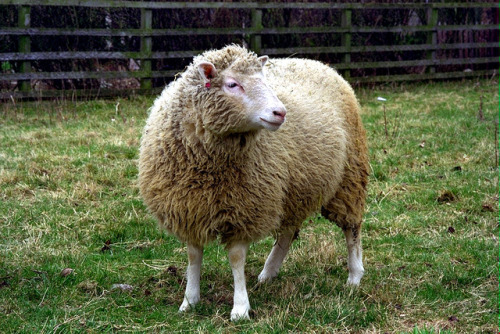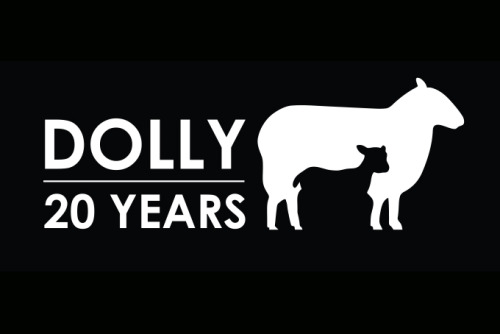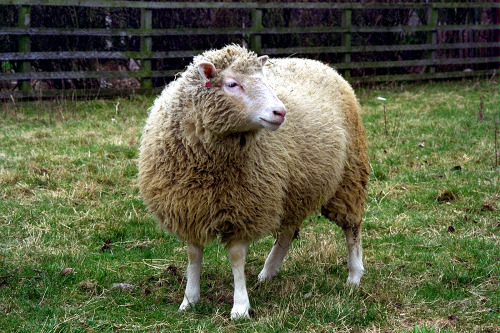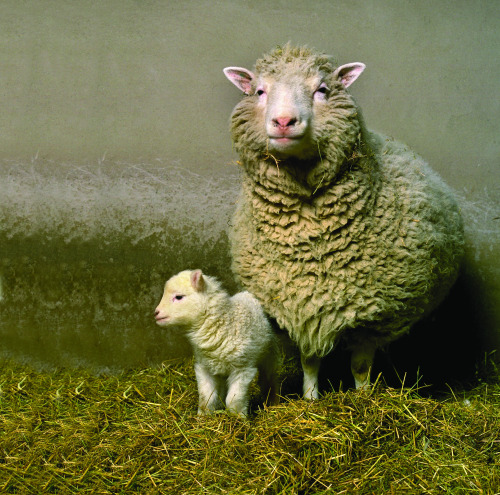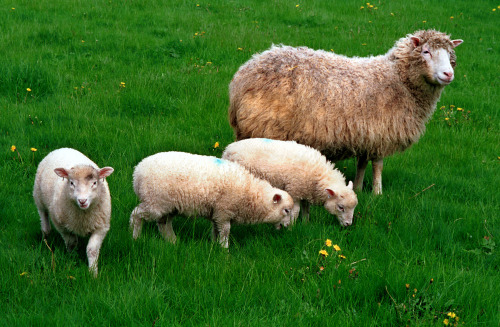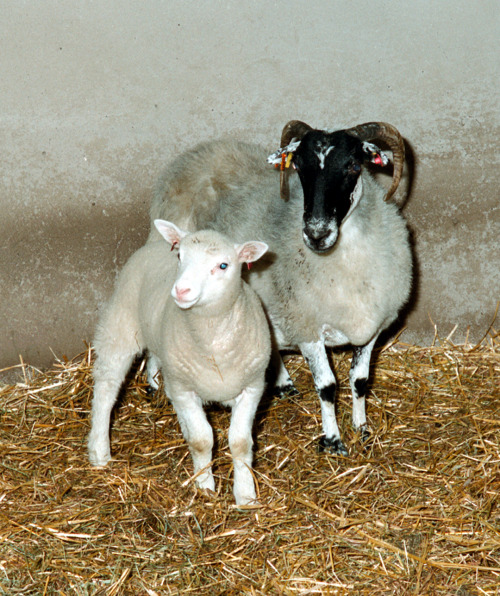#dolly the sheep
A bit of February 22nd history…
1300 - Pope Boniface VIII issues papal bull (decree) instating a Jubilee Year, granting forgiveness of sins and debts for those who fulfill various conditions
1909 - Great White Fleet, 1st US fleet to circle the globe, returns to Virginia
1997 - Dolly the Sheep, world’s 1st cloned mammal is announced
2018 - Neanderthals, not humans, were the 1st artists on Earth, producing red cave paintings 65,000 years ago in Spain (pictured)
2021 - US death toll from COVID-19 passes 500,000, higher than US deaths in World War I, World War II, and the Vietnam War combined
Post link
Dolly at 20
Twenty years ago today on February 22, 1997, Ian Wilmut, Keith Campbell and colleagues at the Roslin Institute, announced the existence of a 7 month old sheep named Dolly, the product of cloning. She was clonedusing and adult cell and born on July, 5, 1996 and raised under the auspices of the UK Ministry of Agriculture and Scottish company PPL Therapeutics. A Dorset Finn sheep, Dolly lived for six and half years before she was euthanized due to illness. Dolly was created with a process called somatic cell nuclear transfer, in which a donor cell (in this case and adult cell from another sheep) has the nucleus removed that is then transfered into an unfertilized egg cell (an oocyte) which in turn has had its cell nucleus removed to make way for the donor nucleus. The host cell is then stimulated and implanted into a host sheep for gestation. Although other animals had been cloned before Dolly, Dolly is celebrated as the first ‘clone’ because her donor cell came from an adult cell.

The word cloneentered English as a noun used in botany in 1903 from the Ancient Greek word klon(κλον) meaning a twigorspray, related to klados(κλαδος) meaning a sprout, young offshoot, branch. Botanists used the word to describe the results of the techique of grafting a shoot of one plant or tree onto another. The word clone(verb) wasn’t used until 1959, and it wasn’t until the 1970s that clone was used in connnection with animals and humans. Since Dolly, scientists have successfully clonedmany other animals, including pigs, horses, goats, and deer.
Image of ‘v’ graft courtesy ghadjikyriacou, via flickr, used with permission under a Creative Commons 3.0 license.
Post link
The ethics of cloning
(Pictured: Dolly the sheep with her Scottish Blackface surrogate mother. One mother wasn’t enough for Dolly; two others helped bring her into existence, providing the egg and her DNA. Born in 1996, Dolly died in 2003 of a fairly common kind of lung cancer in sheep. She nonetheless lives on (in stuffed form) at the National Museums Scotland, close to home.)
Here’s something to think about in preparation for our next article: how ethical is cloning? Let’s start with non-human animals.
Allow me to introduce Dolly the sheep (left). Born to three mothers (one of whom is on the right) in Scotland in 1996, Dolly was the world’s first ever mammal clone. In the UK cloning for the purposes of scientific research is legal upon application.
But in the aftermath of the Dolly’s cloning The European Union deemed the process to be highly controversial. Representatives said ‘the border was too close between animal cloning and cloning on human being[s]’—the ‘slippery slope argument’.
So human life is too precious to clone; animal life is not? In fairness, self-awareness means cloning threatens our existence in special ways. For example, if you were cloned, there wouldn’t be two of you: such a claim would be a contradiction. There is only one you, to whom no one can be identical. But while a clone cannot share your unique identity and your future experiences, they will be fighting for the same identity as you: a stirring thought. Plus there are ethical concerns even with cloning at the primitive stage of human development. These include the ‘death’ (destruction) of many embryos, which are given the moral status of beings, and steps towards eugenics.
However, there are several avenues down which human cloning serves tangible benefits to society. Cloned embryos can be used to create cells in the development of treatments for currently incurable diseases. Reproductive cloning offers hope of parenthood to infertile individuals, same-sex couples, and couples who cannot produce together, enhancing their dignity and familial liberty and bypassing the need for cell donation.
With science we look for ways to design better quality of lives, perhaps at a moral cost. After Dolly the European Union conceded there’s a debate to be held around human cloning for the purposes of medical research. And there’s precedent: in the US human cloning isn’t completely illegal, depending on where you are, and in the UK experimental stem cell research for treating diabetes, Parkinson’s disease, and Alzheimer’s disease is legal, as is three-person in vitro fertilisation.
We continue to foresee ways in which cloning will affect our moral outlooks (e.g. in fiction) and, eerily, who we think we are. The reality of human cloning may be far off. But that won’t stop philosophers, story writers, and us from debating moral issues now in preparation for such a time.
Post link
The life of Dolly the sheep
20 years ago today - Dolly the sheep was born (5th July 1996)
We take a look at the life of the world’s most famous sheep
Making Dolly
Dolly was part of a series of experiments at The Roslin Institute that were trying to develop a better method for producing genetically modified livestock. If successful, this would mean fewer animals would need to be used in future experiments.
Dolly was cloned from a cell taken from the mammary gland of a sheep, and an egg taken from a Scottish Blackface sheep.
She was born to her Scottish Blackface surrogate mom on 5th July 1996.
Dolly’s white face was one of the first signs that she was a clone because if she was genetically related to her surrogate mother, she would have had a black face.
Because Dolly’s DNA came from a mammary gland cell, she was named after the country singer Dolly Parton.
Why was Dolly so important?
Dolly was important because she was the first mammal to be cloned from an adult cell. Her birth proved that specialised cells could be used to create an exact copy of the animal they came from.
Dolly’s life
Dolly was announced to the world on 22nd February 1997. Dolly captured the public’s imagination - no small feat for a sheep - and sparked a public debate about the possible benefits and dangers of cloning.
In the week that followed the announcement, The Roslin Institute received 3,000 phone calls from around the world.
Dolly spent her life at The Roslin Institute, and apart from the occasional media appearance, led a normal life. Over the years, Dolly had a total of six lambs with a ram called David.
After Dolly gave birth to her last lambs in September 2000, it was discovered that she’d become infected by a virus called JSRV, which causes lung cancer in sheep. Other sheep at The Roslin Institute had also been infected with JSRV in the same outbreak.
Dolly continued to have a normal quality of life until February 2003, when she developed a cough. A CT scan showed tumours in her lungs, and the decision was made to euthanise Dolly rather than risk her suffering. Dolly was put to sleep on 14th February 2003, at the age of six.
What made Dolly so special is that she had been made from an adult cell, which no-one at the time thought was possible. This knowledge changed what scientists thought was possible and opened up a lot of possibilities in biology and medicine.
To find out more about the science behind Dolly the sheep, visit www.dolly.roslin.ed.ac.uk.
Post link



